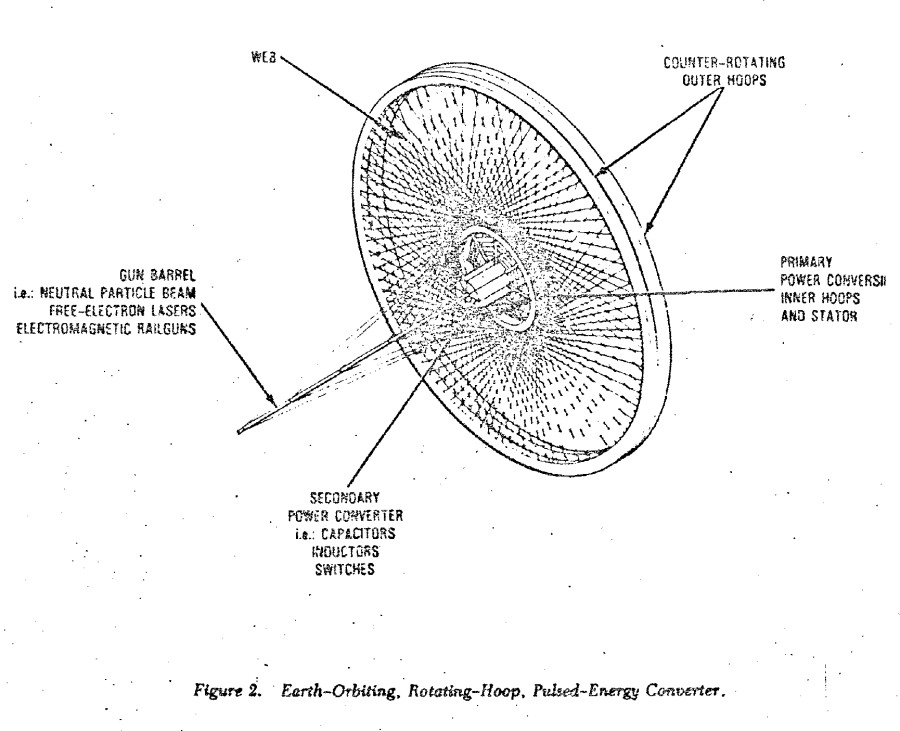Advanced “space guns,” typically lasers, railguns, coilguns, neutral particle beams and the like, have a problem: power. Nuclear reactors and solar panels can provide power for years at a time, but generally their steady-state power output is only a tiny fraction of the instantaneous power needed when the gun goes off. So to run a weapon that needs many gigawatts for a fraction of a second with a powerplant that produces kilowatts, you need an energy storage system that can convert that energy into power on a moments notice. Things like batteries are great in principle, but their weight is vast and their ability to release power at the high levels needed is generally poor.
Often this has resulted in space weapons that use chemical reactions to provide the power needed. This has meant that the total number of shots that can be fired is strictly limited.
In the 1980’s during the SDI heyday, Westinghouse looked at an alternate approach: rotating hoops. Giant wheels made of advanced composite materials would be spun up over time by a low-power system such as a nuclear reactor, and when needed these flywheels would be electromagnetically braked to generate vast amounts of power as the wheels ground to a halt. The system could be “reloaded” by slowly spinning the wheels up again… assuming the system hadn’t torn itself part.
The weapon shown below is probably largely notional, no masses or dimensions were given. But based on a smaller terrestrial unit (with ten hoops, each 14.5 meters diameter, massing 140,000 kg each, spinning at 1800 RPM to deliver a total of 1 gigawatt for 10 minutes to power anti-missile lasers and such), this can be assumed to be a fairly *vast* construction, far heavier than anything mankind has so far launched into orbit. Obviously such a thing would be impossible to launch as a unit; it would be assembled in space using spools of fibers wound in place. Presumably the weapon itself would be at least somewhat aimable independent of the flywheels… slewing *them* about to aim at a moving target would seem to be an exercise in futility.
This came from the paper “Rotating Hoop, Pulsed-Energy Converter” contained in “Transactions of the Fifth Symposium on Space Nuclear Power Systems.” A PDF of that can be downloaded if you go HERE and click the “PDF” button.
Support the APR Patreon to help bring more of this sort of thing to light!


If you’re going to all the trouble of spinning up multi-kiloton flywheels to 2.7km/s tip speed, you may as well skip all the faffing about with power conversion and just ‘drop’ masses from the periphery. Slew on one axis is a bitch, but in the other you ‘slew’ to a desired exit vector almost instantaneously (longest you need to wait is for the next full rotation, or 33.3~ms. Half that if you use counterweighted releases).
Actually the tip speed of a rotating wheel with a diameter of 14.5 meter in diameter rotating at 1800RPM is 1.4km/s, not 2.7km/s.
1800RPM=30Hz
w=2*pi*f=2*pi*30=60*pi
v=R*w=(D/2)*w=(14.5/2)*w
v=7.25*60*pi=1366.59m/s^=1.4km/s
The power/weight ratio is limited by the tensile strength of the materials available. You could probably do as well with nanomaterial capacitors.